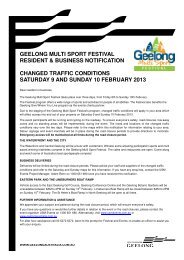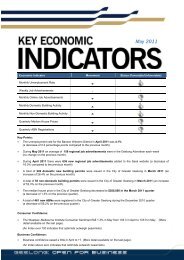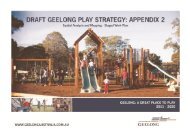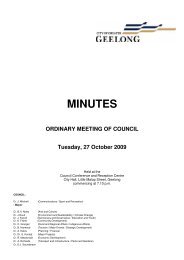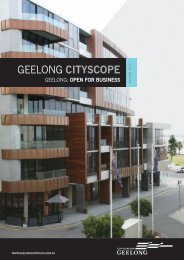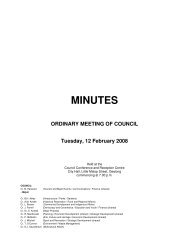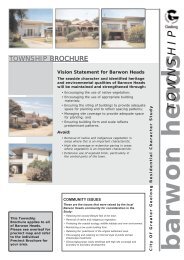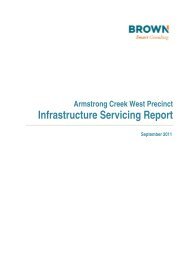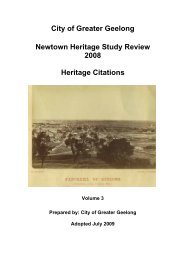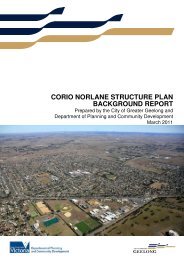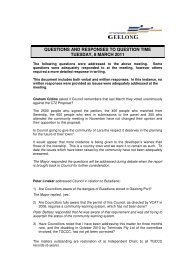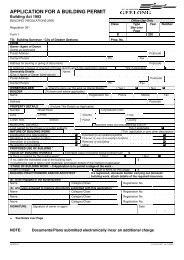armstrong creek urban growth plan volume 1 - City of Greater Geelong
armstrong creek urban growth plan volume 1 - City of Greater Geelong
armstrong creek urban growth plan volume 1 - City of Greater Geelong
Create successful ePaper yourself
Turn your PDF publications into a flip-book with our unique Google optimized e-Paper software.
1 INTRODUCTION<br />
1.1 THE GROWTH OF GEELONG<br />
A man who does not <strong>plan</strong> long ahead will find trouble at his door. Confucius<br />
<strong>City</strong> <strong>plan</strong>ning finds its validation in the intuitive recognition that a<br />
burgeoning market society can not be trusted to produce spontaneously a<br />
habitable, sanitary, or even efficient city, must less a beautiful one. Murray<br />
Bookchin, The Limits <strong>of</strong> the <strong>City</strong> (1986)<br />
The Armstrong Creek Urban Growth Plan (UGP) is one <strong>of</strong> the <strong>City</strong> <strong>of</strong> <strong>Greater</strong><br />
<strong>Geelong</strong>’s largest and most important strategic projects. It aims to concentrate the<br />
majority <strong>of</strong> the <strong>growth</strong> <strong>of</strong> <strong>Geelong</strong> for the foreseeable future into a comprehensive<br />
community in the area south <strong>of</strong> the railway line at Grovedale and Marshall.<br />
There is a well-documented need for additional development to accommodate<br />
<strong>growth</strong> in the <strong>Geelong</strong> region. According to the Draft G21 <strong>Geelong</strong> Region Plan 1 ,<br />
the G21 region 2 “is the fastest growing region in the state, having experience (sic)<br />
population <strong>growth</strong> <strong>of</strong> 1.3% per annum between 1996 and 2005. During that time it<br />
grew at a faster rate than metropolitan Melbourne (1.2%) and Victoria overall<br />
(1.1%) and accommodated on average an additional 3,300 residents each year.”<br />
The Department <strong>of</strong> Sustainability and Environment’s Victoria in Future population<br />
forecasts predict the <strong>Geelong</strong> Region’s population will increase from 254,732 in<br />
2001 to 352,662 in 2031. The G21 <strong>Geelong</strong> Region Alliance (G21)’s population<br />
<strong>growth</strong> scenarios indicate the possibility <strong>of</strong> faster <strong>growth</strong> in the region, resulting in a<br />
population by 2031 <strong>of</strong> up to 510,000 3 . These two forecasts represent between<br />
2,680 and over 7,000 additional people per year. This would result in a need for an<br />
additional 58,000 to 139,000 dwellings by 2031, or between 1,700 and about 4,100<br />
new dwellings per year. It is incumbent upon Council to <strong>plan</strong> to accommodate this<br />
<strong>growth</strong>.<br />
Most <strong>of</strong> Australia’s major cities have now recognised the importance <strong>of</strong> <strong>plan</strong>ning for<br />
1 Draft G21 Region Plan—A sustainable <strong>growth</strong> strategy (2005)<br />
2 The G21 region includes the <strong>Greater</strong> <strong>Geelong</strong>, Surf Coast, Golden Plains, Colac<br />
Otway and Queenscliffe municipalities.<br />
3 This forecast is based on the <strong>growth</strong> rate experienced by the Sunshine Coast<br />
Region between 1996 and 2001.<br />
ARMSTRONG CREEK URBAN GROWTH PLAN / VOLUME 1 (ADOPTED 13 MAY 2008, AMENDED MAY 2010)<br />
7



